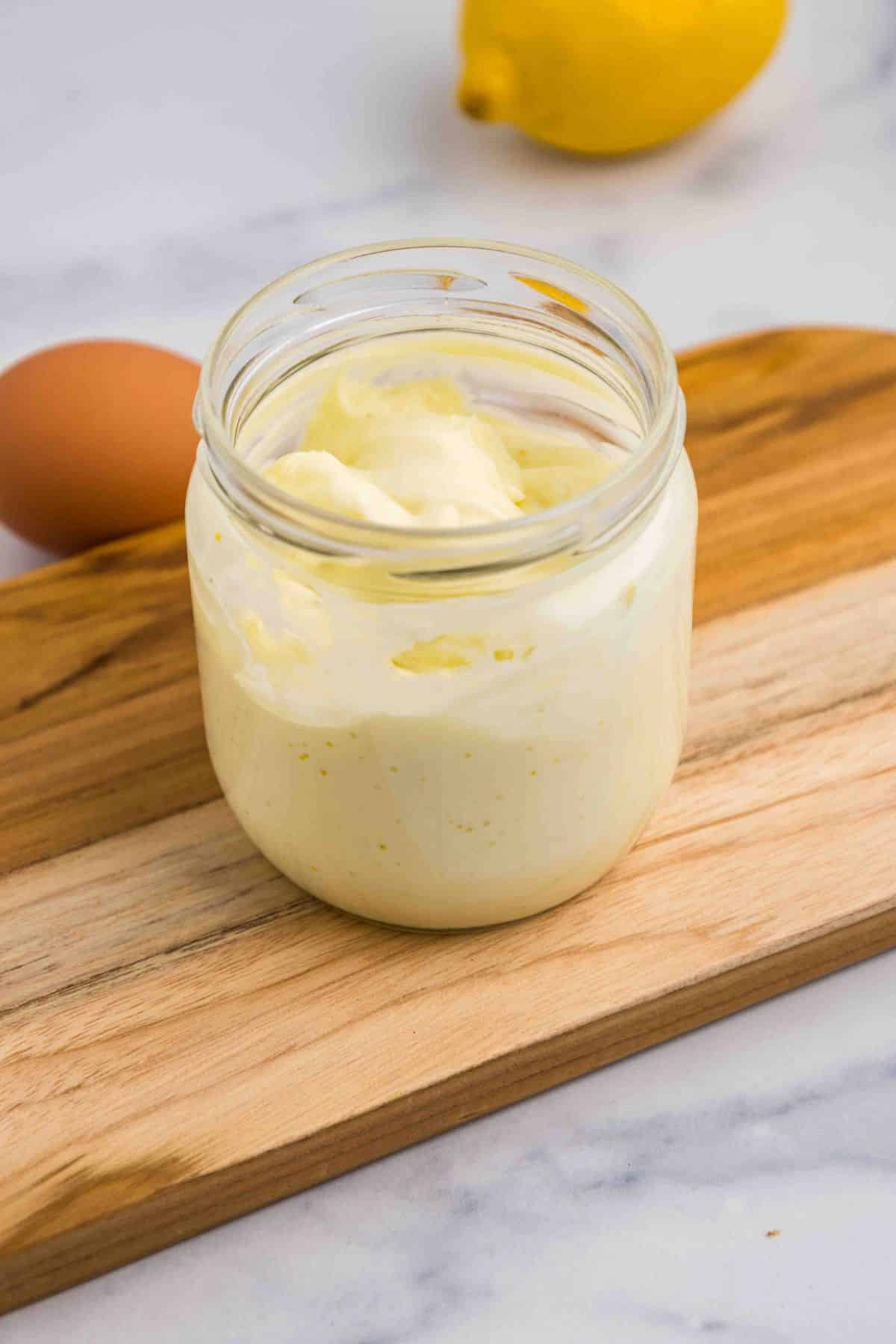Creating your own homemade light mayonnaise is a simple and delicious way to elevate your meals.

Light Mayonnaise
You can avoid the preservatives and additives found in store-bought versions by using just a few ingredients. Plus, you'll have complete control over the flavor and texture of your mayo.
Jump to:
Ingredients Needed for...
Here is a quick look at what you will need. You can find the full measurements in the recipe card below.

- Egg: Egg yolks are key for making mayonnaise creamy and smooth. They help mix everything together so it doesn’t separate. Cage-free eggs can give your homemade mayo a richer taste and are a healthier option. Light mayonnaise uses fewer egg yolks to cut down on fat and calories.
- Light Olive Oil: This is a healthier oil choice compared to regular oils like soybean oil. It keeps the mayo creamy while adding a mild flavor and has fewer calories and trans fats. If you want delicious mayonnaise with some added nutritional benefits, light olive oil is a great pick.
- Lemon Juice: Lemon juice brings a tangy flavor to the mayo and helps keep it fresh by lowering the pH level. You can use fresh lemon juice or concentrate for convenience. Its citrusy taste balances the rich, creamy flavors perfectly.
- Mustard Seed: Mustard seed adds a little kick and lots of flavor to mayonnaise. It also helps keep the mixture smooth and creamy. You can use ground mustard or mustard powder for easier mixing. Mustard also provides some healthy antioxidants.
- Salt: Salt is a simple but important ingredient that boosts all the flavors in mayonnaise. It makes everything taste better and even helps preserve the mayo. Just use enough to bring out the flavors without being overpowering.
See recipe card for quantities.
How to Make
This is a quick overview of the steps. See the Recipe card below for the rest.

To a tall, wide mouth mason jar add the lemon juice egg, seasonings, and the oil.

Put the immersion blender to the way at the bottom of the mason jar before turning it on.

Slowly move the immersion blender up and down being careful not to bring it out of the mayo. Repeat until fully blended.
Variations and Substitutions
- Egg Whites: To reduce the fat content while maintaining the creamy texture, substitute whole eggs with egg whites. This change not only lightens the calorie count but also ensures the mayonnaise remains rich and smooth.
- Greek Yogurt: As a healthy twist, consider incorporating Greek yogurt. It adds a tangy flavor and packs a protein punch, making it an excellent substitute for some of the oil or mayonnaise you might typically use.
- Avocado Oil: For a lighter and more heart-friendly fat option, opt for avocado oil instead of traditional vegetable oil. Avocado oil is high in monounsaturated fats, which can support heart health.

Storage
Storage: Homemade mayonnaise typically lasts for about 3-4 days in the refrigerator. To extend its shelf life, consider adding a squeeze of lemon juice or vinegar to increase acidity and act as a preservative.
Freezing: While mayonnaise can be frozen, it is not recommended as it can separate and become unusable. If you do freeze your homemade mayo, make sure to use it within a month for optimal taste and texture.

Pro Tips
- Use Fresh Ingredients: When freezing mayonnaise dishes, ensure all other ingredients are fresh to maintain the best flavor and quality upon thawing.
- Add Flavors: Consider adding flavors like garlic, herbs, or spices just before serving to enhance the taste of dishes made with thawed mayonnaise.
- Experiment Cubes: Freeze mayonnaise in ice cube trays for smaller, individual portions. This way, you can thaw precisely the amount needed without affecting the remainder.
- Texture Check: Always check the texture of the mayonnaise after thawing. If it's too separated for direct use, try blending it with a little olive oil or a splash of warm water to improve consistency.
- Label and Date: Clearly label and date mayonnaise before freezing to ensure it's used during the period when it's still of good quality, generally within two months.
FAQ
Light mayonnaise contains fewer calories and less fat compared to regular mayonnaise. It achieves this by using a higher proportion of water and a reduced amount of oil and egg yolks. Despite the lower calorie count, light mayonnaise still offers a creamy texture and great taste.
Light mayonnaise is a versatile condiment that can be adapted to various dietary needs, including low-fat diets. However, it’s essential to check the allergen information on store-bought varieties to ensure they meet specific requirements. Homemade versions offer more control over ingredients, making them suitable for personalized diets.
Recipe Card

Light Mayonnaise
Equipment
- Mason Jar
- Immersion Blender
Ingredients
- 1 egg
- 1 cup Light Olive Oil
- 1 tablespoon lemon juice
- ¼ teaspoon Mustard seed
- ¼ teaspoon Salt
Instructions
- To a tall, wide mouth mason jar add the lemon juice egg, seasonings, and the oil.
- Put the immersion blender to the way at the bottom of the mason jar before turning it on.
- Turn on the immersion blender on high speed and leave it at the bottom of the jar for about 20 seconds. The mayonnaise will immediately begin to set.
- Slowly move the immersion blender up and down being careful not to bring it out of the mayo. Repeat until fully blended.
Disclaimer:
Any nutritional data I provide is an approximation and actual dietary information can vary based on ingredients and proportion sizes.







Leave a Reply